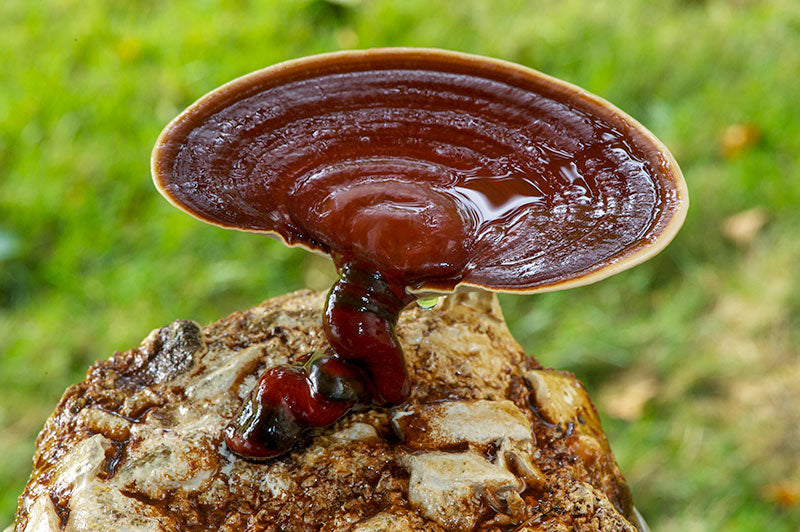
Some Like it HOT: Growing Mushrooms in the Summer Months
For many, the thought of "mushrooms" conjures up images of ancient, dark forests or cold and wet weather. However, this is not always the case. Fungi inhabit every ecosystem on earth, and many of these fascinating organisms tolerate extreme environments such as deserts, polar regions, deep water, and areas of highly salinity. Even the species of the Fungi Perfecti (the species that form mushrooms) can be found inhabiting a diverse range of environments.
Although most of the mushroom-forming fungi we offer thrive in temperate climates like the Pacific Northwest, some species fare quite well as we move into the summer months and temperatures rise. Our mushroom species that can handle the heat include:
Indoor Mushroom Patches:
- Pink Oyster - 70–85 °F
- Reishi - 70–80 °F
- Antler Reishi - 60–80 °F
- Shiitake - 50–80 °F
- King Stropharia - 60–80 °F
Outdoor Mushroom Patches and Plug Spawn:
- Phoenix Oyster - 65–75 °F
- Reishi - 70–80 °F
- Shiitake - 50–80 °F
- Garden Giant - 40 - 90 °F
Even in locations hotter or drier than these mushrooms prefer, there are ways to create a microclimate in which the mushrooms can thrive!
What is a microclimate, you might ask? A microclimate is a smaller area that has slightly different environmental conditions compared to the surrounding areas. If you've ever laid down among tall grass on a hot day, you've probably noticed that it is cooler and more moist the deeper into the grass you reach—that is a microclimate. Often you can feel the air changing as you near a river before you see the water, because of the cooling that happens when water evaporates—that is also a microclimate. Gardeners are used to identifying these; anytime you choose a location for plants based on sun exposure, soil type, or drainage, a microclimate has been identified!
So, what environmental variables should you consider when cultivating these sizzling hot gourmet mushrooms?
- Humidity: Mushrooms still need adequate humidity to fruit, so we encourage cultivators to have ready access to water for their patch, whether indoors or outdoors. Our Indoor Mushroom Patches come with a humidity tent—a perforated plastic covering that conserves moisture close to the patch while still allowing air exchange to occur. For outdoor cultivation, we suggest choosing a site for your mushroom patch or mushroom logs within reach of a garden hose, or another supply of water. Mushroom cultivators often use agricultural shade cloth to create a more ideal environment, and protect the mushrooms from pests while they mature.
- Temperature: While some mushrooms can tolerate temps above 80, the ability to regulate temperature will significantly improve your chances of successful fruiting. Mushroom mycelium can survive and grow at higher temps, but will not fruit unless temperatures are within a certain range. This is easily achievable indoors, as temperatures are below 80 in most homes. Outdoors, identifying a suitable microclimate will help—locations in the shade, next to plants, or near water are often the best. Which leads us to the last major environmental requirement:
- Shade: Indoors, simply locate the patch out of direct sunlight. Outdoors, you can identify a shady location on the North side of your home, under a large tree or bush, or you could suspend agricultural shade cloth above the area. One advantage of shade cloth in particularly dry climates is that it can double as a breathable "humidity tent" — retaining moisture beneath the cloth, and promoting evaporative cooling as the water dissipates.
Many plants and mushrooms are symbiotic and can support each other, in drought and fair weather. Not only can plants offer a cool, shady location where mushrooms can flourish, but many fungi make excellent companions to your plants! Large-leafed plants such as Cabbage or Rhubarb provide excellent cover for a thriving mushroom patch. Mycelium improves soil structure, reduces erosion, nourishes plants, and improves soil's capacity to absorb and retain moisture. By spreading wood chips inoculated with a terrestrial fruiting mushroom, such as the Garden Giant, you can build healthy soil and produce mushrooms too! For more information, see our article Companion Planting with the Garden Giant. Now that's friendship.
As the seasons change and the weather warms, don't leave the mushrooms behind! In many climates, Shiitake logs can produce all Summer long, as can Garden Giant mushroom patches. So make the most of your climate and explore some of these candidates during the warmer seasons. Wherever you are, we're happy to offer advice and support for your cultivation endeavors! And who knows? You could be feasting on some toasty toadstools well before wild mushroom season arrives.
